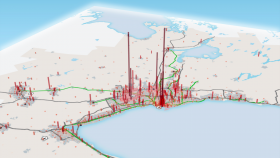Publications
Planning the Next GGH analyses and maps the geography of employment and potential disruption across the Greater Golden Horseshoe (GGH) region.
Author(s):
Report (2018)
This Policy Brief defines and describes the Tor-York West megazone (TYW), one of three regionally, provincially, and nationally significant employment zones identified in the Neptis Foundation report Planning for Prosperity.
Author(s):
Report (2017)
This Policy Brief defines and describes the Tor-York East megazone (TYE), one of three regionally, provincially, and nationally significant employment zones identified in the Neptis Foundation report Planning for Prosperity.
Author(s):
Report (2017)
This report takes a closer look at the Airport Megazone, one of the three suburban employment megazones identified in the 2015 report, Planning for Prosperity, and the second largest concentration of employment in Canada.
Author(s):
Report (2016)
This report maps and analyzes the dynamics of long-term structural changes – not merely cyclical market fluctuations – brought about by globalization and rapidly evolving technology in the economy of the Greater Golden Horseshoe. The report concludes that the Growth Plan for the GGH is not grounded in the reality of the region’s economic geography.
Author(s):
Report (2015)
Neptis has prepared this discussion paper to answer three questions. (1) How does the Growth Plan for the Greater Golden Horseshoe work? (2) Is the region running out of land for development? (3) Have development patterns changed since the Plan was established? The findings are intended to contribute to the 10-year review of the Plan.
Author(s):
Report (2015)
Effects of retail on transportation patterns
Author(s):
Report (2009)
The report highlights effects of long-term business cycles on population growth and housing demand.
Author(s):
Report (2006)
This is the seventh in a series of nine issue papers commissioned by the Neptis Foundation for consideration by the Central Ontario Smart Growth Panel established by the Government of Ontario.
Author(s):
Analysis (2003)
As part of the Portrait of a Region series, this study describes recent trends in municipal revenues and expenditures and compares the fiscal arrangements of the different municipalities within the Greater Toronto Area. The author also looks at the public finance implications of Local Services Realignment (the shift in responsibility for certain services from the provincial to municipal governments), the 1998 amalgamation of six cities into the current City of Toronto, and changes in the property tax assessment system.
Author(s):
Report (2001)
As part of the Portrait of a Region series, this study uses key economic indicators to provide an overview of the economy of the Toronto region at the opening of the 21st century. The study compares Toronto's economy to that of other North American city-regions, highlights the major economic trends of the past 20 years, and assesses the future prospects of the region.
Author(s):
Report (2000)











